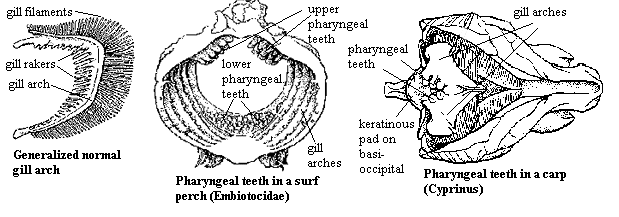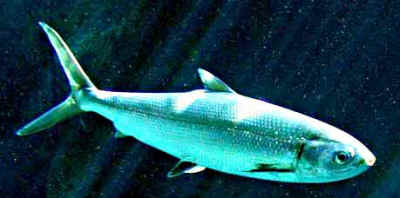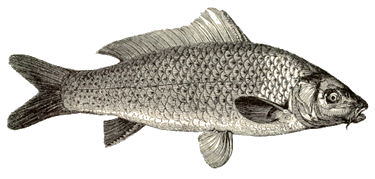 Ostariophysi: goldfish, carps, minnows, catfishes and loaches.
Ostariophysi: goldfish, carps, minnows, catfishes and loaches.| Euteleostei | ||
| The Vertebrates | Euteleostei |
| Vertebrates Home | Vertebrate | Vertebrate |
|
Abbreviated Dendrogram
Teleostei
│
└─Euteleostei
├─Ostariophysi
│ ├─Anotophysi
│ └─Otophysi
│ ├─Cypriniformes
│ └─Siluriphysi
└─Neognathi
├─┬─Salmoniformes
│ └─Esociformes
└─┬─Argentiniformes
└─Neoteleostei
├─Stenopterygii
└─Eurypterygii
├─Cyclosquamata
└─Ctenosquamata
├─Scopelomorpha
└─Acanthomorpha
|
Contents
Overview |
Euteleostei: Normally used as a grade, not a clade, but used here in the sense tuna + piranha.
from the Early Cretaceous
Clupeocephala: Clupeomorpha + * : Ostariophysi + Neognathi.
Description: Long-bodied; large, toothed maxilla; $ additional, often small & fatty fin dorsally between dorsal and caudal fins without separate skeletal support; (adipose fin: presence may be suggested in fossil species by ant displacement of dorsal); primitively, presence of stegural, ant membranous extension of 1st ural neural arch; $ tubercles develop on breeding males (nuptial tubercles); pattern timing and location of tubercles often diagnostic; most species have acellular bone.
Links: no indication for ...an euteleost infradivision (molecular); DEAMBULUM : Animal genomes. APW 040806.
 Ostariophysi: goldfish, carps, minnows, catfishes and loaches.
Ostariophysi: goldfish, carps, minnows, catfishes and loaches.
from the Early Cretaceous. Presently found worldwide except Australia & Antarctica.
Euteleostei : Neognathi + * : Anotophysi + Otophysi.
Characters: generally small size; protrusible jaws (premaxilla) and pharyngeal teeth (separation of feeding from chewing); Weberian apparatus present (actually only in Otophysi); 1st 4 vertebrae shortened [SM02]; stegural present; hypurals numerous; pelvic fins (if present) abdominal; unculi (minute, horny, unicellular 'bumps') usually on mouth and on ventral fins, but can be all over body; distinctive breeding tubercles with keratinous cap; swim bladder divided into three (two?) segments; schreckstoff (alarm pheromone) skin injury release from fright reaction; often highly social.
 Notes: includes 25% of all fish species and 64% [SM02] of fresh water species.
Notes: includes 25% of all fish species and 64% [SM02] of fresh water species.
Image: Above: normal gill arch and arch adapted to include pharyngeal teeth. Below: general scheme of Weberian apparatus. Both images adapted from "lab7-handout.doc" former site).
Links: Ostariophysi; IWR: Taxa: Ostariophysi; WWW Ichthyology Resources; Clupeomorpha, sister-group of Ostariophysi; Molecular and morphological evidence for a clupeomorpha-ostariophysi sister-group relationship (teleostei); Systematics of major fish groups V; lecture14 list of characters); Animal Diversity Web: Ostariophysi: Classification (images); Biology 465- Teleosts II Best on the Web); Ostariophysan Interrelationships.
References: Sanger & McCune (2002) [SM02]. APW 040806.
 Anotophysi: Chanos (milkfishes), Gonorynchus, also ?Phractolaemidae and
?Kneriidae.
Anotophysi: Chanos (milkfishes), Gonorynchus, also ?Phractolaemidae and
?Kneriidae.
Range: from the Early Cretaceous (Late Hauterivian or Early Barremian of Europe). Presently freshwater fishes in Asia & Africa (?).
Phylogeny: Ostariophysi : Otophysi + *.
Characters: Mouth terminal; non-protractile upper jaw; Weberian ossicles absent; cycloid scales; swim bladder present.
Image: Chanos (milkfish) from National Park of American Samoa.
Links: Anotophysi Mikko's Phylogeny); Link to NCBI Front Page; Subphyllum; Ostariophysi; SEAFDEC/AQD - Research Findings - MILKFISH. APW 040806.
Range: from the Early Cretaceous
Phylogeny: Ostariophysi : Anotophysi + * : Cypriniformes + Siluriphysi.
Characters: usually <50 cm, with some up to 200 cm; "sliding" premaxilla; pharyngeal teeth present; $ well-developed Weberian apparatus [SM02]; first neural arch has been modified into the scaphium and claustrum and the second has been modified into the intercalarium [SM02]; neural arches of the third and fourth centra are greatly enlarged [SM02]; $ compound terminal centrum [SM02]; first uroneural fused with compound centrum [SM02]; hypural 2 fused to ural complex; pelvic fins (when present) are abdominal; breeding tubercles common; all fresh water except catfishes; early maturity; Schreckstoff fear pheromone).
Notes: considerable variation in developmental sources of Weberian apparatus within Otophysi. See final run.PM6.
Image: Danio caudal skeleton from [SM02]. Evolved in Gondwana and arrived Laurasia via Africa.
Links: Otophysi Mikko's Phylogeny); Ostariophysi; Comparative osteology of the Danio (Cyprinidae- Ostariophysi) ... pdf file of [SM02]); Link to NCBI Front Page; Systematics of major fish groups V; Ostariophysan Interrelationships; lecture14; Lecture 4; PPT Slide; Biology 465- Teleosts II; Chordata; The Development and Evolution of the Weberian Ossicles in ... (abstract with useful background & references); Ostariophysan Interrelationships (very brief abstract); final run.PM6 (Hoffmann & Britz abstract);
References: Sanger & McCune (2002) [SM02]. APW 040806.
 Cypriniformes: carp (Cyprinus), minnows (including Danio), loaches, goldfishes.
Cypriniformes: carp (Cyprinus), minnows (including Danio), loaches, goldfishes.
Range: from the Early Cretaceous
Phylogeny: Otophysi : Siluriphysi + *.
Characters: ascending process to premaxillae; kinethmoid present (a median bone between ascending processes of premaxillae); palatine articulating in endopterygoid socket; no teeth on jaws; fifth ceratobranchial (the pharyngeal bone) enlarged, with teeth ankylosed to the bone (bound by collagenous fibers to the bone in other ostariophysans with teeth, pharyngeal teeth absent in gyrinocheilids); pharyngeal teeth opposed to enlarged posterior process of basioccipital bone which encloses the dorsal aorta) rather than to upper pharyngeal elements; basioccipital process against which pharyngeal teeth press usually covered by a pad (tough horny pad in cyprinids, soft pad in catostomids); upper jaw usually protractile; branchiostegal rays three; mouth (jaws and palate) always toothless; adipose fin absent (except in some cobitoids); head almost always scaleless; spinelike rays in dorsal fin of some species.
Links: IWR- Taxa- Cypriniformes; Cypriniformes Best on the Web); APUS.RU ├ Cypriniformes Russian); Animal Diversity Web: Order Cypriniformes; (Cypriniformes) Russian); Orders Summary Fishbase); Animal Diversity Web: Cypriniformes: Classification (not much there yet); Cypriniformes; APW 040806.
 Siluriphysi: catfishes & knifefishes, electric eels
Siluriphysi: catfishes & knifefishes, electric eels
Range: from the Early Cretaceous
Phylogeny: Otophysi : Cypriniformes + *.
Characters: double connection of the posttemporo-supracleithral bone to the basioccipital and Weberian apparatus [AV98]; electroreception (re-evolution of a very primitive sensory system).
Links: Link to NCBI Front Page; Ostariophysan Interrelationships; PPT Slide.
References: Adriaens & Verraes (1998) [AV98]. APW 040806.
checked APW 040806.